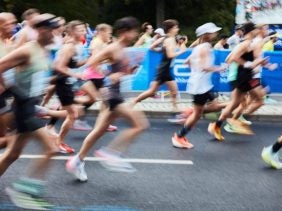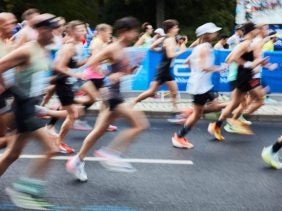Rollerblading: Why This Roller Sport Is a Full Body Workout
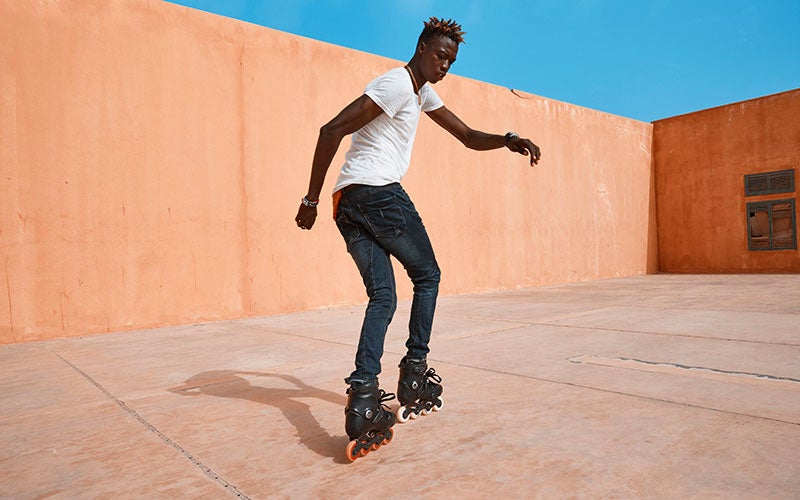 ©Nick Dolding
©Nick Dolding
Rollerblading is making a comeback! This urban activity that was so trendy in the 90s has started to take over the streets once more for good reason. Not only is it fun, it’s also a cardio workout that’s as effective as jogging and even better at building muscle. Keep reading to find out everything you need to know about rollerblading.
What is rollerblading?
Rollerblading or inline skating is a type of roller sport that relies on rollerblades or inline skates to skate on solid ground. The most common shoes have high shafts and four in-line wheels located under the soles. Other varieties, like the classic quad roller skate, are made with two lines of two pairs of wheels. Whichever inline skates you’re using, know that they all move best on smooth, concrete paths.
Though we haven’t seen much of this sport since the ‘90s, rollerblading is finally making a long overdue comeback. Many people have discovered that it’s both a great leisure activity and a workout with tons of variety. In addition to basic rollerblading courses, you can also speed or ramp rollerblade, or even play field hockey. There are so many excellent reasons to consider diving into the world of skating.
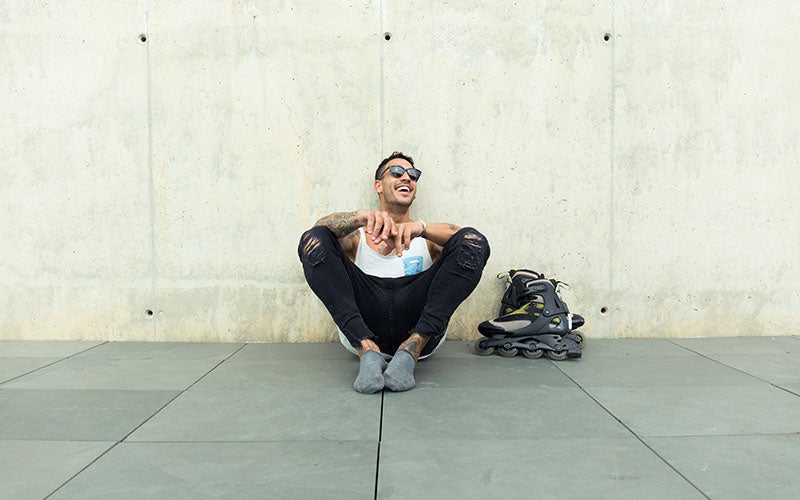
Which muscles does rollerblading train?
Rollerblading is an excellent workout for the lower body. The process involves a lot of pushing and breaking and requires you to launch from a crouched position, all of which are actions that strengthen your butt, thigh, and calf muscles in a targeted way.
But rollerblading happens to be a great core exercise as well. That’s because your abs and back must be constantly activated in order to maintain balance. Practicing this sport regularly can improve coordination and posture, stabilize joints, and help you become more aware of your body in general.
Our tip: Interested in improving your balance? These effective balance exercises will help you do just that and make you a better rollerblader, too!
Is rollerblading good for weight loss?
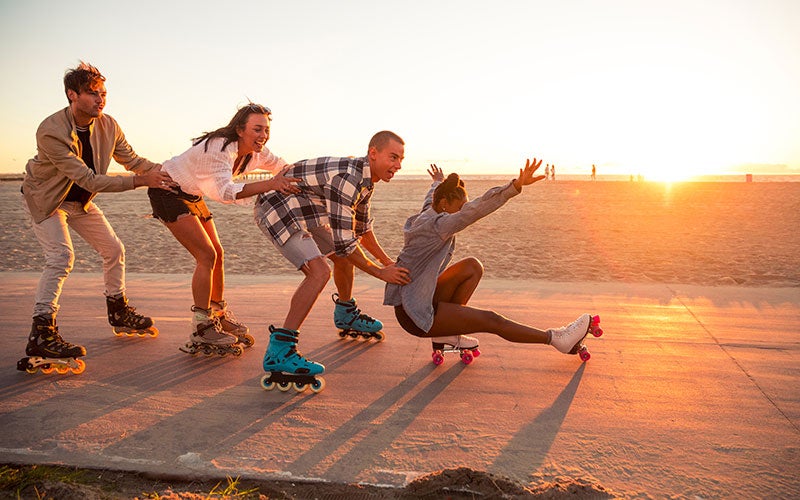
Rollerblading is an ideal activity for losing weight because of the way it combines both strength and endurance training. Rollerblading burns about 400 calories per hour and even more if you incorporate sprints into your practice (2). Of course, it’s important to remember that the amount of calories burned can vary greatly from person to person and depends on factors like age, weight, and physical abilities.
If losing weight is your primary goal, it’s a good idea to combine your rollerblading sessions with additional strength training workouts.
Our tip: Eating a nutritious, balanced diet is essential to reaching your weight loss goals. Our Whey Protein is excellent for ensuring your protein and carbohydrate needs are met. Plus, it’s easy to make and so refreshing after an intense sweat session.
Improve your technique
Whether you’re rollerblading for the first time or warming up after a long break, it’s good to refamiliarize yourself with the basics before hitting the pavement. Here are the techniques you should keep in mind wherever your wheels take you.
#1 Master the starting position
Stand with your legs spaced shoulder or hip width apart and your knees slightly bent. Your feet should point slightly outward. Tilt your upper body forward so that your hips are flexed and your arms are active in front of your torso. Tense your abs to stay balanced.
#2 Find your balance
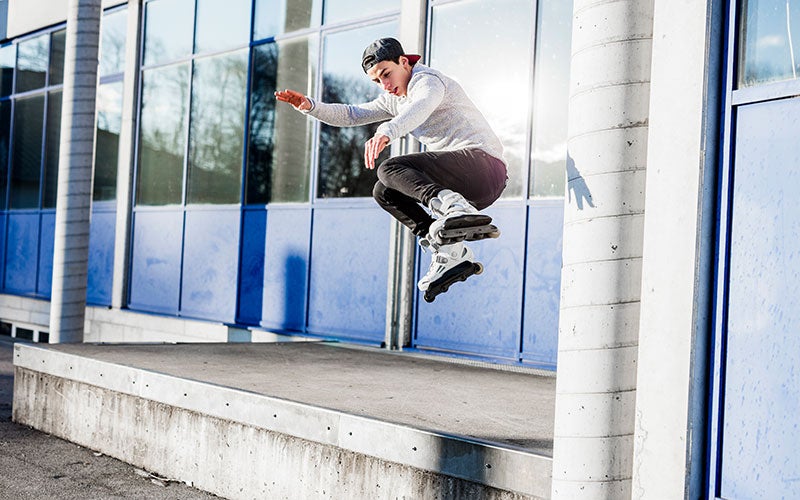
To practice balancing, start by moving one foot forward in a diagonal motion until the heel is in line with the toe of the other foot. While doing this, swing the opposite arm forward so your weight is evenly distributed. Hold this for a moment before swinging your arm and foot back to the starting position. Repeat with the other side.
Alternatively, you can try lifting one foot and placing it behind the other so that the toe touches the heel. This exercise will improve both your balance and the flexibility of your lower body.
#3 Improve your strength
From the starting position, push off your heels and roll your rollerblades forward at the same time. Your legs should spread out into a V shape as you do this. Turn your toes inward, tilting the skates from the inside to the outside. Then, bring your feet together. Repeat these movements until they flow smoothly together. It’ll activate your butt, inner, and outer thigh muscles.
#4 Practice skating steps
The skater’s stride is a technique that’s common in a lot of roller sports—even in ice skating. To do it, start by pushing off of one foot and then shifting your body weight to the other foot. As you slide forward diagonally, your body should form a half-V shape. As one foot moves forward, lower the other foot behind the front heel and push it forward to make the second half of the V shape. Your arms should be actively swinging with each step. Once you have enough momentum, place your feet parallel to each other and slide forward.
#5 Don’t forget about braking
Learning to brake properly is just as important as the other aspects of rollerblading. There are three main ways to do it.
- Buffer braking utilizes the brake pad located at the heel. To do it, transfer your body weight to your support leg, point the ball of your foot, and press your heel into the ground. Bend your knees and lean your upper body forward for stability.
- T-braking requires you to shift your body weight onto your supporting leg and place the opposite foot behind to form a T-shape.
- Snowplow braking — also known as double sole braking — requires you to point your toes toward each other to form an inverted V shape.
#6 Embrace Rollerblading Exercises
Once you’ve nailed the basics, you can move onto more difficult movements. These three exercises are a great starting point for skaters that are past the beginner phase.
Single leg skating: Shift your weight to one leg and skate on that foot as far as you can. Your chin, knee, and skate should form a single line.
Roller turns: As you turn, shift your body weight to the edge of your supporting leg. After you’re comfortable doing this, try to practice turning around obstacles.
Backwards rollerblading: Push on the front wheels and keep your upper body straight. Roll with both skates parallel while forming figure-eight patterns on the ground.
Equipment for riders
If you’re ready to get started on your rollerblading adventure, you’ll need a few important pieces of equipment. Obviously, you can’t begin without rollerblades, but it’s also important to use a helmet and knee, elbow, and wrist guards to prevent injuries.
In general, it’s easier to move quickly over uneven surfaces with larger wheels. Skaters who like to go fast tend to choose wheels that are 100 millimeters in diameter. Those who prefer to rollerblade at a leisurely pace choose wheels between 80 and 84 millimeters in diameter.
Rollerblading: Our conclusion
- Rollerblading or inline skating is a type of sport that involves skating on four wheels that are either mounted one behind the other or in pairs.
- Rollerblading improves balance, strengthens the lower body and core muscles, and improves coordination.
- Rollerblading is an effective full body exercise because it combines strength and endurance exercises.
- Be sure to wear a helmet and protective gear to stay safe on the blacktop.
- Rollerblading is extremely versatile and encompasses variations like ramp skating, speed skating, in-line field hockey, and even roller marathons.
Sources for this article
We at foodspring use only high-quality sources, including peer-reviewed studies, to support the facts within our articles. Read our editorial policy to learn more about how we fact-check and keep our content accurate, reliable, and trustworthy.
- (1) https://www.health.harvard.edu/diet-and-weight-loss/calories-burned-in-30-minutes-of-leisure-and-routine-activities






























